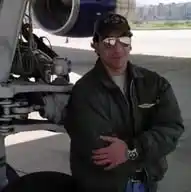
Aviator Fady
0 subscribers
About Aviator Fady
Media platform dedicated to aviation-related content
Similar Channels
Swipe to see more
Posts

📘 1. ICAO Annex 16 – Environmental Protection Annex 16 is divided into four volumes, each covering a different environmental impact of aviation: 🔹 Volume I – Aircraft Noise ▪️Establishes noise certification standards for different aircraft categories. ▪️Aims to limit and reduce aircraft noise at the source. 🔹 Volume II – Aircraft Engine Emissions ▪️Specifies limits for gaseous emissions (NOx, CO, HC) from jet engines. ▪️Supports efforts to mitigate local air quality impacts. 🔹 Volume III – CO₂ Emissions ▪️Introduced a global CO₂ emissions certification standard for aircraft. ▪️Aims to improve fuel efficiency and reduce climate impact. 🔹 Volume IV – Carbon Offsetting and Reduction Scheme for International Aviation (CORSIA) ▪️A global market-based measure to offset CO₂ emissions from international flights. ▪️Includes monitoring, reporting, and verification (MRV) requirements. 🌍 2. Key ICAO Environmental Programs 🛫 CORSIA (Carbon Offsetting and Reduction Scheme for International Aviation) ▪️Adopted in 2016. ▪️Requires airlines to purchase carbon offsets for emissions growth above 2020 levels. ▪️Phased implementation: Pilot Phase (2021–2023), First Phase (2024–2026), Mandatory from 2027 (for most states). 💨 Aircraft Engine Emissions Standards ICAO has adopted standards for: ▪️Hydrocarbons (HC) ▪️Carbon monoxide (CO) ▪️Oxides of nitrogen (NOx) ▪️Smoke and particulate matter (PM) 🔊 Balanced Approach to Aircraft Noise Management ICAO promotes a four-pillar "Balanced Approach": 1. Reduction of noise at source 2. Land-use planning and management 3. Noise abatement operational procedures 4. Operating restrictions (as a last resort) 🔧 3. ICAO Tools and Resources ✅ State Action Plans ▪️ICAO encourages states to develop national Action Plans on CO₂ emissions reduction. ▪️Allows states to set measures (technology, operations, alternative fuels). ⛽ Sustainable Aviation Fuels (SAF) ▪️ICAO supports the development and deployment of SAF. ▪️Encourages lifecycle carbon reductions and environmental sustainability. 📊 Environmental Tools Suite ICAO provides tools like: ▪️ICAO Carbon Emissions Calculator ▪️Environmental Benefits Tool (EBT) ▪️CORSIA Central Registry (CCR) ⚖️ 4. Legal and Strategic Framework 🔹 Chicago Convention (1944) Provides ICAO’s legal authority over environmental standards in civil aviation. 🔹 ICAO Assembly Resolutions ▪️Resolutions from the triennial ICAO Assembly guide environmental action, including: ▪️A40-18: Consolidated statement on continuing policies and practices. 🔹 Long-Term Aspirational Goal (LTAG) ICAO is working toward achieving net-zero CO₂ emissions by 2050 for international aviation.
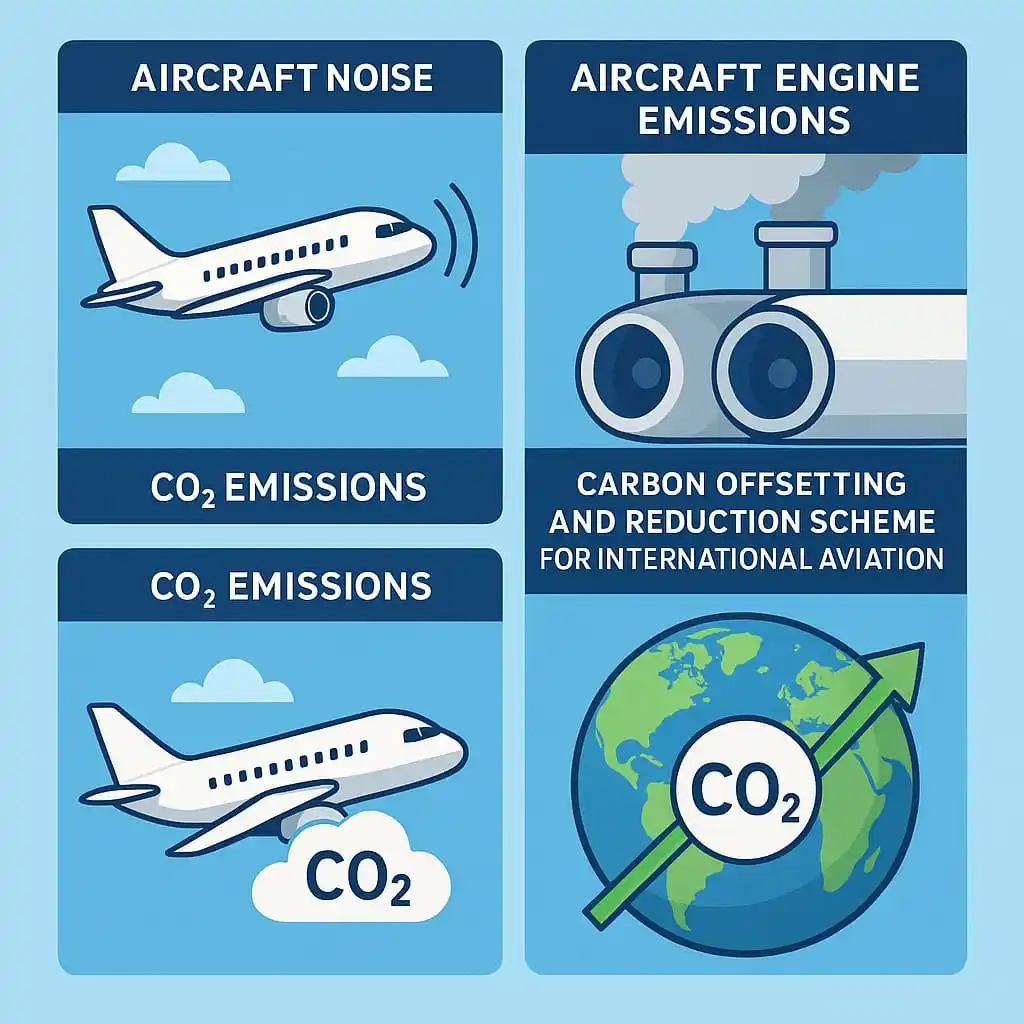

✈️ ICAO Annex 16 – Volume I: Aircraft Noise Title: Environmental Protection – Aircraft Noise Objective: To limit and reduce the impact of aircraft noise on communities around airports by setting international noise certification standards. 🔹 Key Components 1. Noise Certification Standards Defines maximum allowable noise levels during specific flight phases: ▪️Takeoff ▪️Sideline (lateral during climb) ▪️Approach These limits vary by: ▪️Aircraft type (jet, propeller) ▪️Maximum takeoff weight (MTOW) ▪️Engine configuration 2. Noise Categories ("Chapters") ✈️Aircraft are classified under different Chapters based on noise levels: Chapter 2: Older, noisier aircraft (now largely phased out) Chapter 3: Quieter standards introduced in the 1970s Chapter 4: Stricter limits than Chapter 3 Chapter 14: Most stringent; applies to newer aircraft (effective 2017 for jets, 2020 for props) 3. Measurement & Testing Noise is measured at: ▪️Lateral: 450 m from runway centerline ▪️Flyover: 6.5 km from brake release point ▪️Approach: 2 km before threshold ▶️Standard atmospheric and flight conditions are specified. 4. Applicability ▪️Applies to new aircraft designs and production. ▪️Older aircraft can be "retrofitted" to meet standards or face restrictions. 📉 Noise Reduction Strategy Annex 16 Volume I supports ICAO’s Balanced Approach: 1. Reduce noise at source (quieter aircraft designs) 2. Land-use planning around airports 3. Noise abatement procedures (e.g., flight paths, altitude) 4. Operating restrictions (last resort) 🌐 Implementation by States ▪️ICAO member states adopt these standards through national regulations. ▪️States may restrict non-compliant aircraft (e.g., bans on Chapter 2 aircraft in many regions). ✅ Benefits ▪️Reduces community noise exposure. ▪️Encourages innovation in quieter aircraft. ▪️Harmonizes noise rules globally to support international aviation.
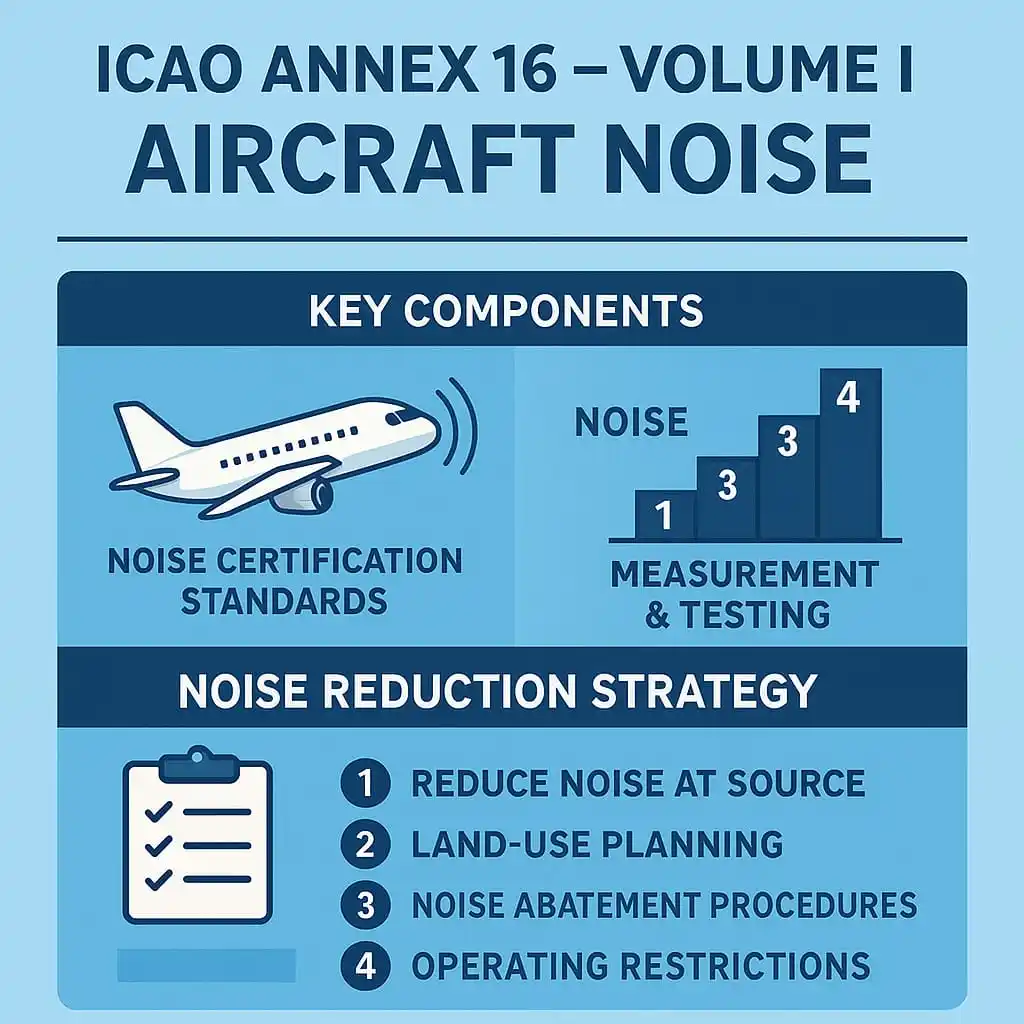

✈️ ICAO Annex 16 – Volume II: Aircraft Engine Emissions Title: Environmental Protection – Aircraft Engine Emissions Objective: To limit and control emissions from aircraft engines that impact local air quality and contribute to climate change. 🔹 Key Components 1. Applicable Emissions Focuses on emissions from turbojet and turbofan engines with thrust > 26.7 kN, specifically: ▪️Nitrogen oxides (NOₓ) ▪️Hydrocarbons (HC) ▪️Carbon monoxide (CO) ▪️Smoke and particulate matter (PM) 2. Certification Standards Emissions are tested during four operating modes: ▪️Idle ▪️Approach ▪️Climb-out ▪️Takeoff Results are compared to ICAO’s regulatory emission limits. 3. Testing Procedures ▪️Engine emissions are measured under controlled conditions (test benches). Standardized using: ▪️Landing and Takeoff (LTO) Cycle: Represents emissions near airports (up to ~3,000 ft). ▪️Prescribed engine settings, fuel flow, and ambient conditions. 4. Smoke & Particulates ▪️Limits on visible smoke are enforced for aesthetic and pollution concerns. ▪️Newer standards also address non-volatile particulate matter (nvPM). 5. Applicability ▪️Applies to new engine types and sometimes retroactively to older models under recertification. ▪️Manufacturers must demonstrate compliance for each engine model. 🌍 Environmental Impact ☢️Pollutant ▶️Effect ☢️NOₓ ▶️Contributes to ozone formation & acid rain ☢️CO ▶️Toxic gas, harmful to health ☢️HC▶️ Contributes to smog and ozone ☢️Smoke/nvPM ▶️Reduces visibility, harms respiratory health
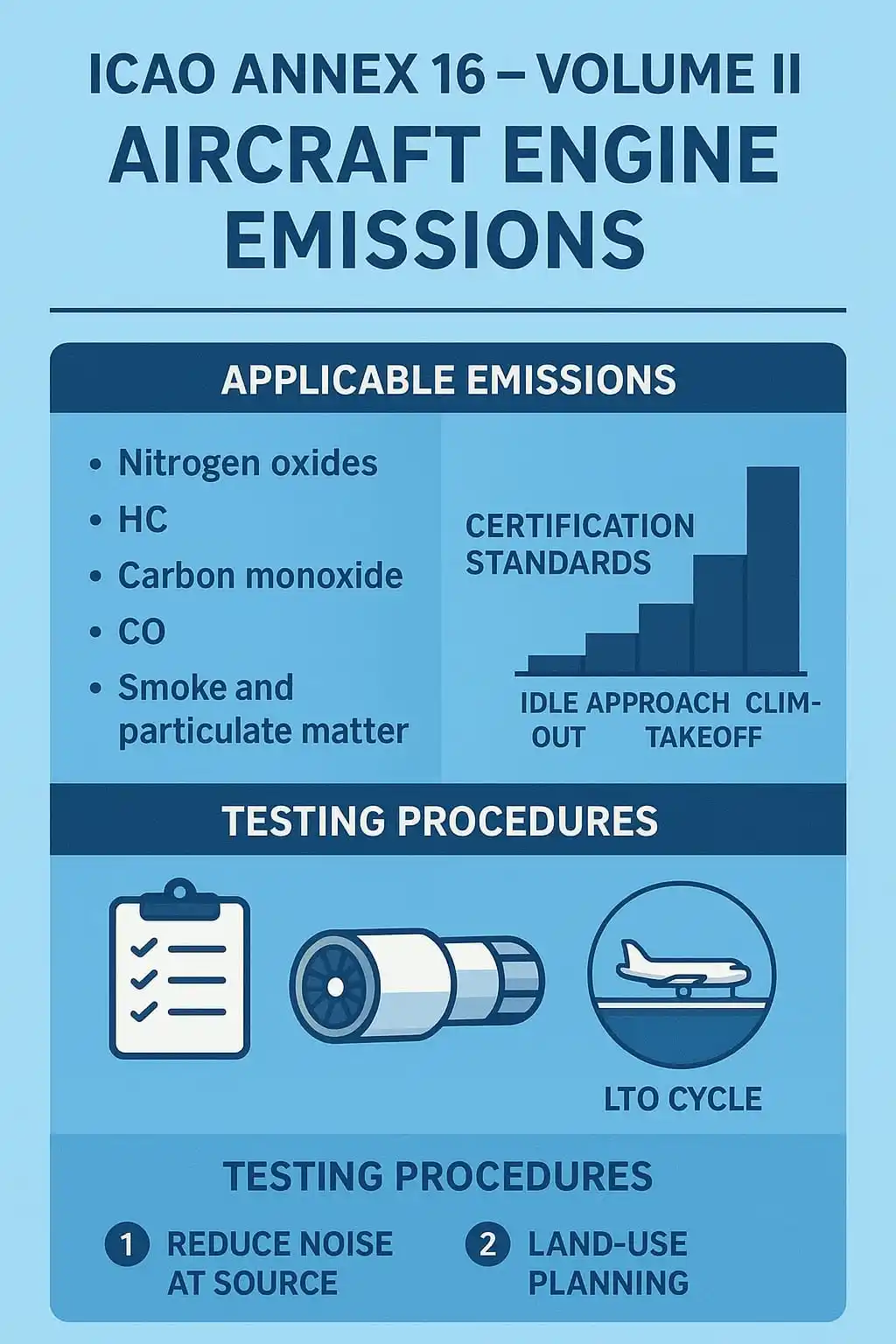

✈️ Non-Volatile Particulate Matter (nvPM) refers to tiny solid particles emitted from aircraft engines that do not evaporate under normal atmospheric conditions. These are primarily soot or black carbon particles produced during the combustion of jet fuel. 🔬 Key Characteristics of nvPM: ▪️Non-volatile: Unlike volatile particles (e.g., unburned hydrocarbons), nvPM remain solid after emission and do not evaporate. ▪️Ultrafine: Typically less than 100 nanometers in diameter. ▪️Carbon-based: Composed mainly of elemental carbon (soot). ▪️Emitted during incomplete combustion, especially at high engine power settings. 🏥 Health & Environmental Impact: ▪️Health: Can penetrate deep into lungs and bloodstream, causing respiratory and cardiovascular issues. ▪️Climate: Contributes to global warming by absorbing sunlight (black carbon effect). ▪️Air Quality: Affects local air quality around airports. 📏 ICAO Standards and Measurement: ICAO Annex 16, Volume II includes certification standards for nvPM: ▪️Measured as: ▶️Mass concentration (mg/kg of fuel burned) ▶️Number concentration (particles/kg of fuel) ▪️Testing is conducted using a specialized sampling system under specific engine conditions. ⚙️ Mitigation Strategies: ▪️Improved engine design for better combustion. ▪️Use of cleaner fuels (e.g., Sustainable Aviation Fuel - SAF). ▪️Engine maintenance to ensure optimal performance.
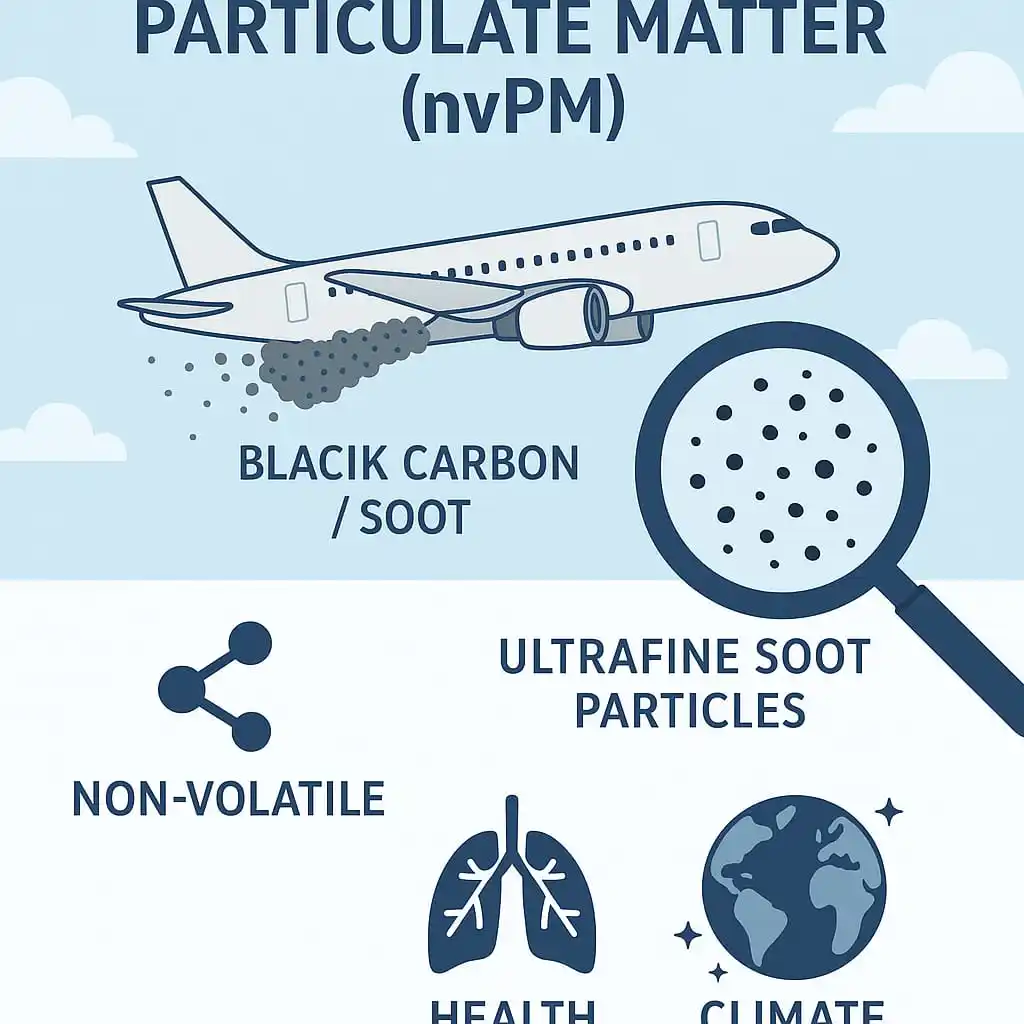

✈️ An aircraft accident is considered to have occurred in international sea waters (also called the high seas) when it takes place outside the territorial waters of any country. Definition of International Sea Waters: ▪️According to the United Nations Convention on the Law of the Sea (UNCLOS): ▪️Territorial waters extend 12 nautical miles from a country’s coastline. ▪️Beyond that, up to 200 nautical miles is the Exclusive Economic Zone (EEZ), but the EEZ does not include full sovereignty like territorial waters. ▪️International waters, or high seas, begin beyond 12 nautical miles from any country’s coast and are not under the jurisdiction of any single state. 🌐Application to Aircraft Accidents: When an accident occurs: ▪️Within 12 nautical miles of a coastal state → it's within that state's territory. ▪️Beyond 12 nautical miles → it's considered to have occurred in international waters. 📘 ICAO Annex 13 (Aircraft Accident Investigation) - Key Point: 🌏 Even if the accident occurs in international waters, the State of Registry of the aircraft has the responsibility to conduct or delegate the investigation, unless another arrangement is made. ✈️ Example: If an aircraft crashes 15 nautical miles off the coast of Country X, it is officially considered to have occurred in international waters, and Country X does not automatically have jurisdiction over the investigation, though they may assist.
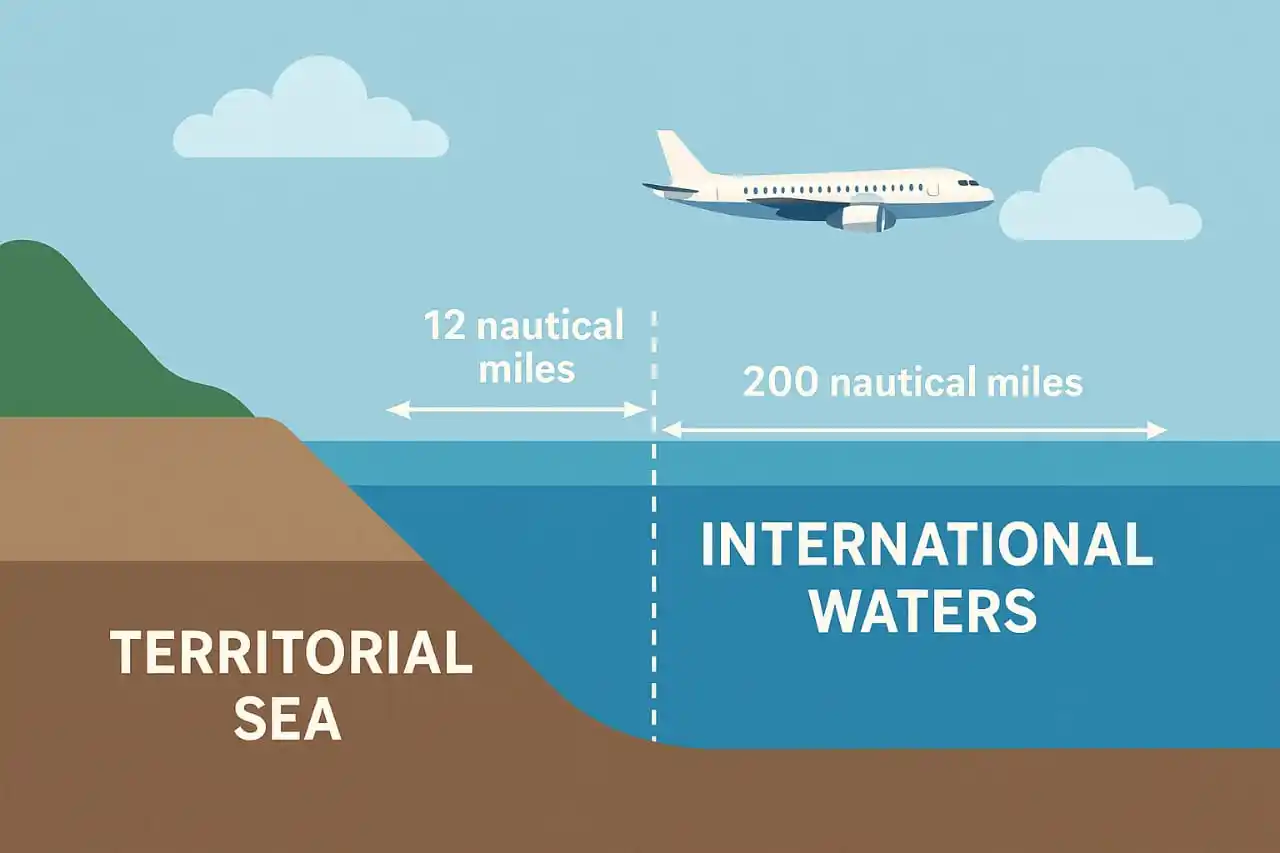

✈️ In an aircraft accident investigation, certain tasks are time-critical due to the risk of losing perishable evidence, environmental degradation, or unauthorized tampering. Acting quickly helps preserve vital data and supports an accurate analysis of the causes. ✅ Time-Critical Tasks & What Must Be Recorded Quickly: 1️⃣. Site Security & Evidence Preservation ▪️Secure the accident site immediately to prevent disturbance or contamination. ▪️Set up perimeter control to restrict access to authorized personnel only. ▪️Photograph and document the initial condition of the wreckage and surroundings before moving anything. 2️⃣. Wreckage Documentation ▪️Record the exact location and distribution of aircraft debris (impact marks, wreckage spread, fire damage). ▪️Use photos, videos, GPS coordinates, and sketches. ⚠️Pay special attention to: ▪️Flight control surfaces ▪️Engine positions ▪️Landing gear status ▪️Instrument readings (frozen gauges) 3️⃣. Flight Recorders Retrieval ▪️Locate and recover: ▪️Flight Data Recorder (FDR) ▪️Cockpit Voice Recorder (CVR) ▪️Secure and send them to a specialized lab for prompt data extraction. 4️⃣. Witness Statements Collect statements from: ▪️Survivors ▪️Eyewitnesses ▪️First responders ▪️ATC personnel ▪️Do this as soon as possible, while memories are still fresh. 5️⃣. Perishable Data Collection ▪️Radar data, ATC recordings, weather data, and surveillance videos must be secured quickly before automatic overwriting. ▪️Collect aircraft maintenance records, crew duty logs, and air traffic clearance tapes. 6️⃣. Environmental Evidence ▪️Record weather conditions, light levels, and visibility at the time of the accident. ▪️Take air and soil samples if fire, fuel leaks, or hazardous cargo is involved. 7️⃣. Biological and Forensic Evidence ▪️Time-sensitive for: ▪️Toxicology tests on crew members ▪️Survivability analysis ▪️Injury pattern mapping
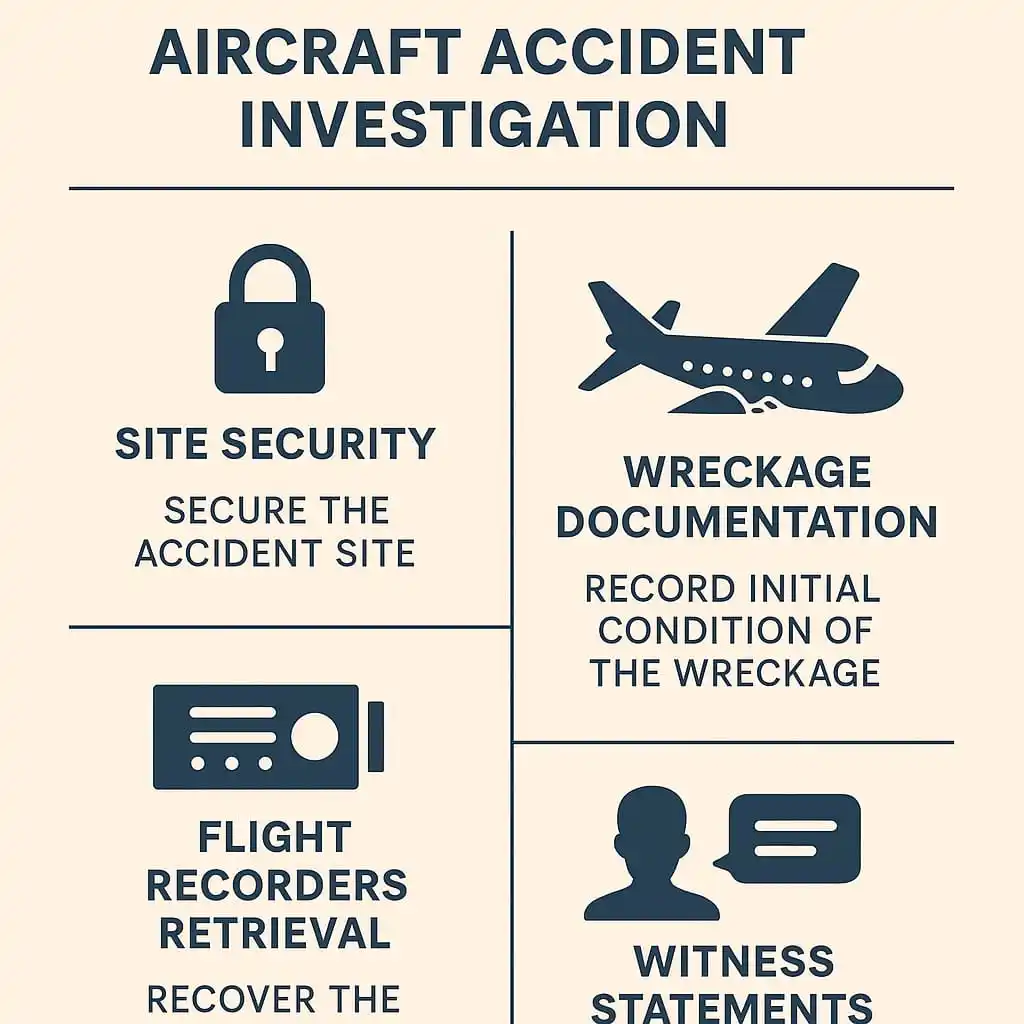

Windshear? It’s a sudden change in wind speed or direction, and one of the most dangerous types occurs during a microburst—a powerful downdraft of air from thunderstorms! Here’s what happens: 🔹 The aircraft is on final approach, following the glide slope. 🔹 It first encounters a headwind, momentarily increasing airspeed and lift. 🔹 Then, it flies into a strong downdraft, pushing it towards the ground. 🔹 Finally, it encounters a tailwind, rapidly reducing airspeed and lift—causing a severe loss of altitude. Without quick action, the aircraft may not have enough altitude or power to recover before hitting the ground! That’s why pilots are trained to execute a windshear recovery, applying full power and climbing away from danger. Advanced windshear detection systems have made flying safer, but microbursts still pose a serious challenge. Next time you see stormy weather, you’ll know why pilots take extra precautions! #Aviation #Windshear #Microburst #PilotTraining #FlightSafety

Horizontal Situation Indicator (HSI) The Horizontal Situation Indicator (HSI) is a critical instrument in aviation, combining heading, navigation, and course deviation into one display. Key Components: 🛩️ Navigation & Guidance: • Lubber Line – Indicates the current aircraft heading. • Compass Card – Displays cardinal and intermediate headings. • Course Select Pointer – Shows the selected navigation course. • TO/FROM Indicator – Determines if the aircraft is flying toward or away from a navigation station. ⚡ Flight Path & Deviation Indicators: • Course Deviation Bar (CDI) – Shows lateral course deviation. • Glideslope Deviation Scale & Pointers – Helps maintain proper vertical descent. 🚨 Warnings & Adjustments: • NAV & Compass Warning Flags – Indicate a loss of signal or instrument failure. • Course & Heading Select Knobs – Allow pilots to adjust the desired course and heading. Essential for precision navigation and instrument landings, the HSI enhances situational awareness and flight control.












